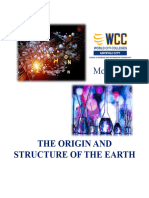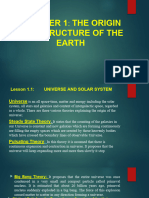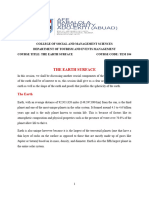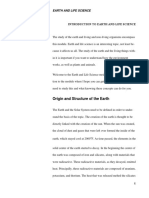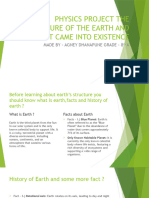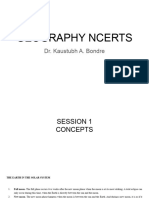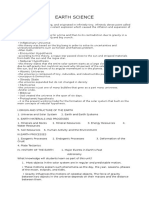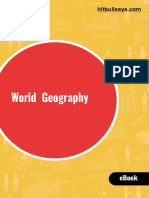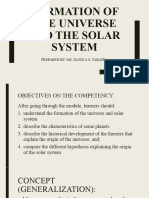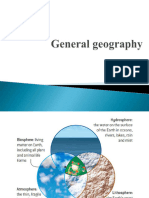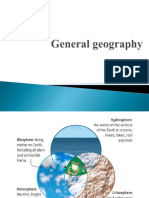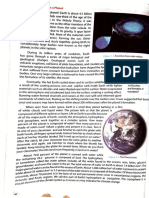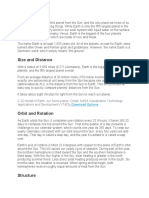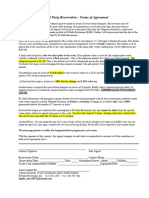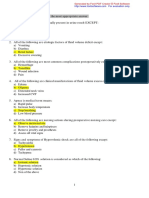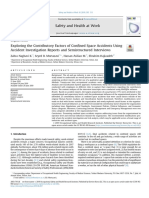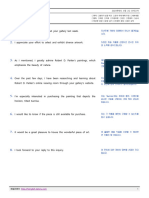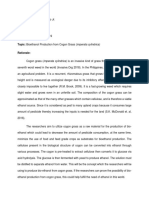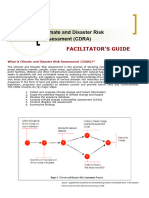Group2 (Earth Science Report)
Group2 (Earth Science Report)
Uploaded by
Swellyn Kate SerranoCopyright:
Available Formats
Group2 (Earth Science Report)
Group2 (Earth Science Report)
Uploaded by
Swellyn Kate SerranoOriginal Title
Copyright
Available Formats
Share this document
Did you find this document useful?
Is this content inappropriate?
Copyright:
Available Formats
Group2 (Earth Science Report)
Group2 (Earth Science Report)
Uploaded by
Swellyn Kate SerranoCopyright:
Available Formats
MODULE 2
STRUCTURE AND DESIGN OF THE PLANET EARTH
THE PLANET EARTH
The Earth is the third planet from the sun and the fifth largest, most massive and dense of
the solar system’s four terrestrial planets. It is sometimes referred to as the world Blue Planet or
Terra.
Earth is the only place in the universe where life is known to exist. The planet form 4.54
billion years ago and life appeared on its surface within a billion years. Since then, Earth’s
biosphere has significantly altered the atmosphere and other abiotic conditions on the planets,
enabling the proliferation of aerobic organisms as well as the formation of the ozone layer which
together with Earth’s magnetic field, blocks harmful radiation, permitting life on land.
The physical properties of the Earth, as well as its geological history and orbit, allowed
life to persists during this period. The world is expected to continue supporting life for another
1.5 billion years, after which the arising luminosity of the sun will eliminate the biosphere.
THE SIZE OF THE PLANET EARTH
About 2,000 years ago, a Greek mathematician and astronomer named Eratosthenes
calculated the size of the earth. He did this by measuring the distance between a deep well to
Syene and Alexandria and the angle of moon and sun that found the angle to be a little more than
seven degrees (7 0) which is almost 1/50th of complete circle. Thus , the distance between the well
and Alexandria must be approximately 1/50th of the earth’s circumference. The Eratosthenes on
the circumferences of the earth was about 43,200km.
The same basic method is still used today to determine the size of earth. Precise
measurement of the angles of the celestial bodies from different location are made accurate
measurement of the distance between these points are also made.
Before the time of Isaac Newton, it was believed that the earth was perfectly round.
However, Newton proved that the earths circumference at the poles was less than the
circumference at the equator. It diameter at the equator is about 43.2 km greater than the
diameter at the poles. Scientist agree that the slight bulge is caused by rapid rotation of earth on
its axis which makes the earth’s shape spherical.
THE SHAPE OF THE EARTH
The Study of size and shape of earth is called Geodesy.
Geodesy – Accurately measuring and understanding the Earth's geometric shape, its orientation
in space, its gravity field, and changes in these properties over time.
Earth’s shape is known as an oblate spheroid, which the Term ‘Oblate’ refers to its
slightly oblong appearance. While ‘Spheroid ‘means that it is almost sphere, but not
quite. This is the characterized by a spherical object that is slightly flattened at its poles
and slightly bulging at its center. Long before photographs of the Earth were seen, early
people had already some pieces of evidence to conclude that the Earth is not flat, but
spherical.
MOTION OF THE PLANET EARTH
ROTATION, REVOLUTION, AND PRECESSION
Rotation - is the turning of an object on an axis, whereas Revolution is motion in an
orbit. Thus, the earth rotates daily and revolves yearly around the sun. The earth rotates from the
West to East on an axis joining its North and South poles.
Earth’s rotation - is the rotation of the solid earth around its own axis. The earth rotates
from the west toward the east. Earth rotates once in about 24 hours from the point of view of the
sun and once every 23 hours 56 minutes and 4 seconds from the point of view of the stars Earth’s
rotation is slowing slightly with time.
The Earth’s orbit around the Sun has many interesting characteristics. First, the speed of
our orbits is 108,000 km/. The Earth completes one orbit every 365. 242199 means solar days
(that might help explain the need for the Leap Year).
Leap Year – A year that contains 366 days, with February 29 as an additional day.
Perihelion - It is when the Earth is closest to the sun, this occurs around January 3rd at a
distance of 147,098,074 km.
Aphelion - It is the further distance from the sun, this happened around July 4th at a
distance of 152,097,701 km.
LOCATION OF POINTS ON THE SURFACE OF THE EARTH
The most common way to locate points on the surface of the earth is by standard,
geographic coordinates called latitude and longitudes.
Latitude – Is the measurement of distance north or south of the Equator. It is measured
with 180 imaginary lines that form circles around Earth east-west, parallel to the Equator.
These lines are known as parallels
Longitudes – measures distance east or west of the prime meridian. Lines of longitude,
also called meridians, are imaginary lines that divide the Earth. They run north to south
from pole to pole, but they measure the distance east or west.
We can imagine the earth as a sphere, with an axis around which it spins.
The end of the axis are the North and South poles.
The Equator is a line around the earth, an equal distance from both poles, it
also the latitude line given the value of 0 degrees.
EARTH’S FORMATION AND EVOLUTION
Scientist think Earth was Formed at roughly the same at time as the sun and other planets
4.6 billion years ago, when the solar system came from a giant, rotating cloud of gas and dust
known as the Solar Nebula.
As the nebula collapsed because of its gravity, it spun faster and flattened into a disk.
Most of the materials was pulled toward the center to form the sun. Other particles within the
collided and stuck together to form ever –larger bodies, including Earth.
The History of Earth is divided into four eons – starting with the earliest, they are:
Hadean – Designating the time before rocks formed on the earth which was then a
molten mass, and when the solar system was forming.
Archean – It is the earliest eon of geological history or the corresponding system of
rock.
Proterozoic – The younger of the two divisions of Precambrian time, the older being is
Archean.
Phanerozoic – is the current geologic eon in the geologic time scale, and the one during
which abundant animals and plant life has existed. It covers 538.8 million years to the
present.
The first three eons, which together lasted nearly 4 billion years, are together known as the
Precambrian. Evidence in life has been found in the Archaean about 3.8 billion years ago, but
life did not become abundant until the Phanerozoic.
Precambrian - The Precambrian is the earliest part of Earth's history, set before the
current Phanerozoic Eon. The Precambrian is so named because it preceded the
Cambrian, the first period of the Phanerozoic Eon, which is named after Cambria.
The Phanerozoic is divided into three eras – starting with the earliest, these are the
Paleozoic, Mesozoic and Cenozoic.
The Paleozoic Era – saw the development of many kinds of animals and plants in the
seas and on land.
The Mesozoic Era – was at the age of dinosaurs.
The Cenozoic Era – at the age of mammals.
STRUCTURE OF THE EARTH’S INTERIOR
The Earth is a dynamic system constantly changing as matter and energy are transferred
among its different parts. It includes the following subsystem.
1. Geosphere – the solid Earth including all the materials that comprise the crust,
mantle and core.
a. Crust – The solid and relatively thin, layer of geosphere and it lies down both
landmasses and oceans.
TYPES OF CRUST
1. Continental – made up of mostly granite, schist and gneiss, this type forms the
obvious continental land mass. This has a thickness of 10 to 75 km and has a density
of 2.7g/cm3
2. Oceanic – made up of basaltic rock, this forms the seafloor of oceans. It has
thickness of 5 to 8 km and has a density of 3.0 g/cm3.
b. Mantle – the middle part of geosphere, sandwich between the crust and the
core. This layer accounts for about two- third of the earth’s total mass.
Earth’s crust floats on the mantle much as a wood float on water, and tee slow
motions of rock in the mantle shuffles continent around and causes earthquakes,
volcanoes and the formations of mountain ranges.
SUB PARTS OF THE MANTLE
1. Asthenosphere – is located in the uppermost potion of the mantle, characterized as
plastic, mobile layer of the earth’s geosphere which extends around the earth. It is believed that
plates are actually floating on this layer like giant’s ice floating on the ocean.
2. Mesosphere – Comprises the rest of the mantle. It is about 2,300km thick, and even
though temperature is higher here, this part of the mantle is solid
Mohorovicic Discontinuity – a zone that serves as a boundary between the crust and the mantle.
c. Core – the innermost part of the geosphere. It is sub divided into:
1. Outer Core – Earth’s liquid outer core is about 2,300 km thick. As a result of
extremely high temperatures, this region is made up of molten iron and nickel because of
extremely high temperature. This liquid help produce the earth’s magnetic field.
2. Inner Core – The planet’s innermost part, is about 1,200 km thick and is made up of
solid iron and nickel. Temperature of the inner core may reach 5500^0 𝑐.
3. Hydrosphere – all the water of the earth (ocean, rivers, lakes, groundwater, etc.)
including glacier and other frozen water.
4. Atmosphere – the envelop of gases that surrounded the earth (oxygen, nitrogen,
carbon dioxide, etc.); and
5. Biosphere – the sum of all living matter on the earth.
Reference :
https://www.nationalgeographic.org ›Earth Structure | National Geographic Society
Wikipedia
https://en.m.wikipedia.org › wiki Internal structure of Earth - Wikipedia
Earth Structure | National Geographic Society
Geological Survey Ireland https://www.gsi.ie › education › Pages The Earth's Structure
Encyclopedia Britannica https://www.britannica.com › science Hadean Eon | Start, Timeline, &
Facts
Wikipedia https://en.m.wikipedia.org › wiki Hadean
Wikipedia https://en.m.wikipedia.org › wiki Phanerozoic
https://www.britannica.com › science Proterozoic Eon | Oxygen Crisis, Animals, & Facts
You might also like
- Earth Science (Group 2)Document27 pagesEarth Science (Group 2)Swellyn Kate SerranoNo ratings yet
- The Solar System Earth ScienceDocument6 pagesThe Solar System Earth ScienceMamta ChandNo ratings yet
- Material 6ºDocument42 pagesMaterial 6ºjuandelmonte64No ratings yet
- Venus, Earth MarsDocument10 pagesVenus, Earth Marsrufino delacruzNo ratings yet
- Earth Science: Origin and Structure of The Earth (Part I) : The Big Bang TheoryDocument6 pagesEarth Science: Origin and Structure of The Earth (Part I) : The Big Bang TheoryAnonymous BQuEhS4ETNo ratings yet
- EarthDocument20 pagesEarthShiela Mae RegualosNo ratings yet
- Solar & Earth SystemDocument30 pagesSolar & Earth SystemMA RI AHNo ratings yet
- 1 - Origin of Earth and Evolution of The EnvironmentDocument12 pages1 - Origin of Earth and Evolution of The Environmentcoolnidhi134558No ratings yet
- EnvironmentDocument629 pagesEnvironmentSanchay SaxenaNo ratings yet
- Earth and EarthquakesDocument32 pagesEarth and Earthquakesnymufti100% (4)
- Module PsDocument24 pagesModule Psjeffrey alemaniaNo ratings yet
- Eals Week 0 DoneDocument31 pagesEals Week 0 DoneAlejandro SantosNo ratings yet
- d1 Life ScienceDocument35 pagesd1 Life Scienceheyhuhey2006No ratings yet
- Science - An Elementary Teacher's Guide - A History of Planet Earth - Wikibooks, Open Books For An Open WorldDocument24 pagesScience - An Elementary Teacher's Guide - A History of Planet Earth - Wikibooks, Open Books For An Open WorldrozaidhanyNo ratings yet
- Inbound 196982161366132526Document21 pagesInbound 196982161366132526San DraNo ratings yet
- 1586554044the Earth Surface 3Document6 pages1586554044the Earth Surface 3adeolujoseph06No ratings yet
- EarthDocument9 pagesEarthAbdulkareem BHNo ratings yet
- Origin of EarthDocument73 pagesOrigin of Earthsaksham111No ratings yet
- Geo Sample Book Ugc NetDocument48 pagesGeo Sample Book Ugc NetNeha ChouhanNo ratings yet
- Earth As A PlanetDocument60 pagesEarth As A PlanetR Amravatiwala100% (1)
- 2ND TERM - Earth ScienceDocument17 pages2ND TERM - Earth ScienceRaals Internet CafeNo ratings yet
- مادة التربة الأفريقيةDocument29 pagesمادة التربة الأفريقيةnet secureNo ratings yet
- Earth and Life Science Module 1 NotesDocument4 pagesEarth and Life Science Module 1 NotesKathlyn BesaNo ratings yet
- Nios Environment Material Mrunal OrgDocument643 pagesNios Environment Material Mrunal OrgVinod KumarNo ratings yet
- Earth and Life Science. Chapter 1Document14 pagesEarth and Life Science. Chapter 1veronicaNo ratings yet
- Formation of EarthDocument54 pagesFormation of Earthniaz ahmedNo ratings yet
- 2.1 Basic Review of EarthDocument48 pages2.1 Basic Review of EarthPrabhat GautamNo ratings yet
- Science Chapter 2 Earth and Earth SystemDocument4 pagesScience Chapter 2 Earth and Earth SystemCazandraShynne RabinoNo ratings yet
- Word-NIOS 1Document33 pagesWord-NIOS 1punit gehiNo ratings yet
- Page 273 - 281Document11 pagesPage 273 - 28105 陳宗榮 RYAN GERALD CHUANo ratings yet
- GeologyDocument15 pagesGeologyBea AntoqueNo ratings yet
- Els Handouts Q1Document22 pagesEls Handouts Q1Joseph LabradorNo ratings yet
- Earth & Life Science: (Lesson 1: The Universe and The Solar System) (Lesson 2: Earthy Materials and Processes)Document22 pagesEarth & Life Science: (Lesson 1: The Universe and The Solar System) (Lesson 2: Earthy Materials and Processes)EJ RamosNo ratings yet
- Geology Literally Means "Study of The Earth."Document49 pagesGeology Literally Means "Study of The Earth."Abdul Moeed KalsonNo ratings yet
- En - 1.1 - Explaining Planet EarthDocument2 pagesEn - 1.1 - Explaining Planet EarthClaudia Alejandra AlarconNo ratings yet
- Physics Project The Structure of The EarthDocument9 pagesPhysics Project The Structure of The EarthAgney DhanapuneNo ratings yet
- Geology and The Earth Part 2Document32 pagesGeology and The Earth Part 2Jed EnricusoNo ratings yet
- Foundation of Geography PPT - Part 01Document49 pagesFoundation of Geography PPT - Part 01rohan.salunkeNo ratings yet
- 2.advancements and Discoveries On The Solar SystemDocument15 pages2.advancements and Discoveries On The Solar SystemMaGladys Casem-Mendoza CastilloNo ratings yet
- Earth Scienceppt. GRADE 11Document47 pagesEarth Scienceppt. GRADE 11Mary Grace Manaeg HerederoNo ratings yet
- Earth and Life Science ModulesDocument6 pagesEarth and Life Science ModulescaroljoycaisNo ratings yet
- Earth ScienceDocument7 pagesEarth ScienceSuzanne LlorcaNo ratings yet
- Geography 1st CSEDocument117 pagesGeography 1st CSEVicente Pérez NavarroNo ratings yet
- World GeographyDocument103 pagesWorld GeographyAnurag BhartiNo ratings yet
- THE EARTH AND BEYOND UNit 6Document16 pagesTHE EARTH AND BEYOND UNit 6Florensius Yusthianus ManerNo ratings yet
- Formation of UniverseDocument39 pagesFormation of Universenzjnbftjf4No ratings yet
- Geography Opt 1Document1,939 pagesGeography Opt 1vijayapriya2001pNo ratings yet
- Geography OptionalDocument2,715 pagesGeography Optionalvijayapriya2001pNo ratings yet
- First Term SS 1 GeographyDocument12 pagesFirst Term SS 1 Geographygracenjoku68No ratings yet
- Earth and Life ScienceDocument16 pagesEarth and Life ScienceKylene AgusteroNo ratings yet
- Scan 2 May 2019Document13 pagesScan 2 May 2019Veronica MayeNo ratings yet
- Planet Earth Is Awesome!: 101 Incredible Things Every Kid Should KnowFrom EverandPlanet Earth Is Awesome!: 101 Incredible Things Every Kid Should KnowNo ratings yet
- Planet Earth: Facts About Its Orbit, Atmosphere & SizeDocument4 pagesPlanet Earth: Facts About Its Orbit, Atmosphere & SizeFlorie Fe Rosario OrtegaNo ratings yet
- Size and DistanceDocument5 pagesSize and DistanceJulianne Rose AggalutNo ratings yet
- Earth Sci and Gen BioDocument9 pagesEarth Sci and Gen BioxxxiluvgdrgnNo ratings yet
- Lesson 1 The Formation of The Universe & The Solar System 2Document2 pagesLesson 1 The Formation of The Universe & The Solar System 2solivasravennicaNo ratings yet
- Earth ScienceDocument11 pagesEarth Scienceحمائل سجادNo ratings yet
- Geology: A Fully Illustrated, Authoritative and Easy-to-Use GuideFrom EverandGeology: A Fully Illustrated, Authoritative and Easy-to-Use GuideRating: 3.5 out of 5 stars3.5/5 (10)
- LEAB ABC ChargersDocument12 pagesLEAB ABC Chargersmna478No ratings yet
- BC Act and Reg Amendments Circular 19dec08Document5 pagesBC Act and Reg Amendments Circular 19dec08wmleung0909No ratings yet
- 11 - Tata Power Fire Safety Management ProcedureDocument11 pages11 - Tata Power Fire Safety Management Procedurehse bsjNo ratings yet
- Research Ppt. Group 6Document4 pagesResearch Ppt. Group 6Nathan L. OctavianoNo ratings yet
- Description Power Range: Analog Servo DriveDocument8 pagesDescription Power Range: Analog Servo DriveElectromateNo ratings yet
- Small Party Reservation - Terms of AgreementDocument1 pageSmall Party Reservation - Terms of AgreementSANDRA MADRIDNo ratings yet
- Telecollaborative E-Notebook: Loretta Cooper Azusa Pacific SPRING 2013Document13 pagesTelecollaborative E-Notebook: Loretta Cooper Azusa Pacific SPRING 2013oooper8No ratings yet
- The King and I: Watching Henrik LundqvistDocument3 pagesThe King and I: Watching Henrik LundqvistjbisnoffNo ratings yet
- Magazine For Intermodal Exchange and DevelopmentDocument33 pagesMagazine For Intermodal Exchange and Developmentrui wang311No ratings yet
- Pub - Training Games Everything You Need To Know About U PDFDocument222 pagesPub - Training Games Everything You Need To Know About U PDFR J100% (1)
- مهم للمزاولةDocument13 pagesمهم للمزاولةbelal nurseNo ratings yet
- Exploring The Contributory Factors of Confined Space Accidents Using Accident Investigation Reports and Semistructured InterviewsDocument9 pagesExploring The Contributory Factors of Confined Space Accidents Using Accident Investigation Reports and Semistructured InterviewsAprilia Nur HanisaNo ratings yet
- Inflamasi Akut Dan KronikDocument60 pagesInflamasi Akut Dan KronikDhea Resty PratiwiNo ratings yet
- Installation VERO VISSIDocument3 pagesInstallation VERO VISSISimon RisteskiNo ratings yet
- Tens PDFDocument62 pagesTens PDFJay Muhammad100% (1)
- M100 - Quickstart Guide PDFDocument4 pagesM100 - Quickstart Guide PDFUncleNIXNo ratings yet
- Ring PopDocument34 pagesRing PopJoey NicolasNo ratings yet
- (23 3 2)Document28 pages(23 3 2)idyejun901No ratings yet
- MoluscaDocument52 pagesMoluscaDeni SugiantoroNo ratings yet
- Pricelist Etienne 2024Document13 pagesPricelist Etienne 2024schatziarditaNo ratings yet
- Title Proposal Project StudyDocument7 pagesTitle Proposal Project StudySiN XNo ratings yet
- A Study On Second Language Learners PDFDocument8 pagesA Study On Second Language Learners PDFAzura W. ZakiNo ratings yet
- User'S Manual: Cuces3Document8 pagesUser'S Manual: Cuces3khaledNo ratings yet
- Access at This Point - With Perhaps 15-20 Percent of Research Articles Made FreelyDocument23 pagesAccess at This Point - With Perhaps 15-20 Percent of Research Articles Made FreelyIchlasulNo ratings yet
- Cns BaDocument7 pagesCns BakumudhaveniNo ratings yet
- Creader Crp12x User Manual enDocument49 pagesCreader Crp12x User Manual enJesus Almanzar Santos100% (1)
- Noun in English Grammar With Examples With PDFDocument8 pagesNoun in English Grammar With Examples With PDFConstantin Alexandru67% (3)
- Physics 71 1st Long ExamDocument12 pagesPhysics 71 1st Long ExamAb YZNo ratings yet
- Cdra Faci GuideDocument17 pagesCdra Faci GuideGhia PornillosNo ratings yet
- Autonomous Aerial Refueling For Uavs UsingDocument11 pagesAutonomous Aerial Refueling For Uavs UsingSalil SharmaNo ratings yet










